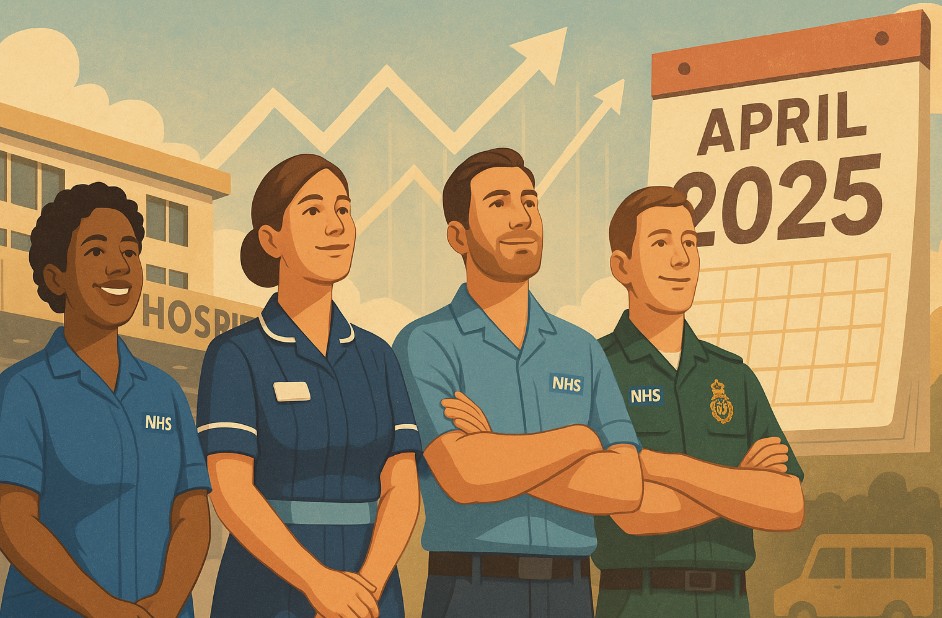On 22 May 2025, the UK Government officially announced a 3.6% pay increase for NHS staff in England and Wales, set to take effect from 1 April 2025. This decision follows recommendations from the NHS Pay Review Body and ongoing consultations with unions, healthcare professionals, and public sector economists.
This annual adjustment affects employees working under the Agenda for Change contract, which includes nurses, midwives, healthcare assistants, paramedics, and most allied health professionals.
With pressures mounting due to inflation, workforce shortages, and increased demand for services, this pay award aims to enhance staff retention, support recruitment efforts, and deliver a message of value and recognition to NHS employees.
In the context of public sector reform and financial constraints, the 2025/26 NHS pay award marks a notable intervention by the government to maintain service continuity and safeguard the morale of over one million NHS workers across the UK.
What Is the NHS Pay Rise for 2025/26?
The 3.6% pay rise introduced for 2025/26 represents an across-the-board uplift in NHS salaries, including both annual and hourly pay, as well as Higher Cost Area Supplements (HCAS) in London and surrounding areas.
Key Aspects
- Effective from 1 April 2025
- Covers all staff under Agenda for Change
- Applies to both full-time and part-time contracts
This increase also reflects a broader policy shift toward improving working conditions in the public sector and aligns with recent government pledges to support essential services amid economic uncertainty.
Government Context and Comparison
- The 3.6% uplift is slightly above the UK’s projected inflation rate for 2025, estimated at 3.2%.
- It follows a 5% increase in 2023/24, but precedes several years of below-inflation rises.
- Seen as a move to stabilise staffing in the NHS post-pandemic, amid rising operational costs and workforce attrition.
How Does Pay Progression Work Across NHS Bands in 2025/26?

In the 2025/26 NHS pay structure, staff salaries increase not only through general pay awards but also through incremental progression within pay bands. This structure rewards experience and service time, ensuring that staff members are recognised as they develop skills and take on greater responsibilities.
Each band is divided into step points, typically moving from entry level to intermediate and then to a top pay point, based on a number of years served and performance outcomes.
Annual Pay Progression Overview by Band
The following table summarises the entry, intermediate, and top pay points, along with the typical number of years required to progress within each band:
| Band | Entry Point | Intermediate Point | Top Point | Time to Top Point |
| Band 1* | £24,465 | – | £24,465 | N/A (band closed to new entrants) |
| Band 2 | £24,465 | – | £24,465 | 2 years |
| Band 3 | £24,937 | – | £26,598 | 2 years |
| Band 4 | £27,485 | – | £30,162 | 3 years |
| Band 5 | £31,049 | £33,487 | £37,796 | 4 years (2 + 2) |
| Band 6 | £38,682 | £40,823 | £46,580 | 5 years (2 + 3) |
| Band 7 | £47,810 | £50,273 | £54,710 | 5 years (2 + 3) |
| Band 8a | £55,690 | £58,487 | £62,682 | 5 years (2 + 3) |
| Band 8b | £64,455 | £68,631 | £74,896 | 5 years (2 + 3) |
| Band 8c | £76,965 | £81,652 | £88,682 | 5 years (2 + 3) |
| Band 8d | £91,342 | £96,941 | £105,337 | 5 years (2 + 3) |
| Band 9 | £109,179 | £115,763 | £125,637 | 5 years (2 + 3) |
What Does This Mean for NHS Staff?
- Structured salary progression ensures fairness and predictability.
- Pay development is based on time in post and performance appraisals.
- Most bands follow a 2 + 3 year split two years to intermediate, followed by three more to top pay.
- For lower bands (2–4), there is typically no intermediate step, and progression is quicker.
This tiered model promotes career growth, encourages long-term service, and supports overall workforce retention and satisfaction in the NHS.
How Will the NHS Pay Scales Change in 2025/26?

The NHS pay scales for 2025/26 have undergone a structured update as part of the latest 3.6% pay increase across England and Wales. This change is particularly significant for NHS staff employed under Agenda for Change, which governs most non-medical roles across the service.
These revised pay scales are designed to ensure a fair and progressive salary structure, allowing staff to progress financially as they gain experience and demonstrate performance within their roles.
Each pay band consists of entry, intermediate, and top step points, with varying lengths of time required before employees are eligible to progress.
Key Highlights of the 2025/26 Annual NHS Pay Bands
| Band | Entry Point | Intermediate | Top Point | Years to Progress |
| Band 1* | £24,465 | – | £24,465 | N/A – Closed to new entrants |
| Band 2 | £24,465 | – | £24,465 | 2 years |
| Band 3 | £24,937 | – | £26,598 | 2 years |
| Band 4 | £27,485 | – | £30,162 | 3 years |
| Band 5 | £31,049 | £33,487 | £37,796 | 2 + 2 years |
| Band 6 | £38,682 | £40,823 | £46,580 | 2 + 3 years |
| Band 7 | £47,810 | £50,273 | £54,710 | 2 + 3 years |
| Band 8a | £55,690 | £58,487 | £62,682 | 2 + 3 years |
| Band 8b | £64,455 | £68,631 | £74,896 | 2 + 3 years |
| Band 8c | £76,965 | £81,652 | £88,682 | 2 + 3 years |
| Band 8d | £91,342 | £96,941 | £105,337 | 2 + 3 years |
| Band 9 | £109,179 | £115,763 | £125,637 | 2 + 3 years |
Note: Band 1 is closed to new entrants and remains static in pay.
Understanding Band Progression
Each band is structured to promote career development within the NHS:
- Entry Step Point: The starting salary when staff join or are promoted to a new band.
- Intermediate Step Point (where applicable): Reached after 2 years, this recognises early-career contribution and development.
- Top Step Point: Typically achieved after 5 years total (2 + 3 years), reflecting maximum experience and performance within the band.
This incremental pay rise model rewards longevity, skill enhancement, and dedication in roles and is integral to NHS workforce retention strategies.
Real-World Example
Consider a registered nurse starting in Band 5:
- Year 1–2: £31,049 per year
- Year 3–4: £33,487 per year
- Year 5 onwards: £37,796 per year
Over time, this progression provides financial stability and recognises professional growth.
What Are the Updated Hourly Pay Rates by Band?
Here’s a detailed breakdown of the hourly pay across all bands for 2025/26:
| Band | Entry Rate | Intermediate Rate | Top Rate | Years to Top |
| Band 1* | £12.51 | – | £12.51 | N/A – Closed to new entrants |
| Band 2 | £12.51 | – | £12.51 | 2 years |
| Band 3 | £12.75 | – | £13.60 | 2 years |
| Band 4 | £14.06 | – | £15.43 | 3 years |
| Band 5 | £15.88 | £17.13 | £19.33 | 4 years |
| Band 6 | £19.78 | £20.88 | £23.82 | 5 years |
| Band 7 | £24.45 | £25.71 | £27.98 | 5 years |
| Band 8a | £28.48 | £29.91 | £32.06 | 5 years |
| Band 8b | £32.96 | £35.10 | £38.30 | 5 years |
| Band 8c | £39.36 | £41.76 | £45.35 | 5 years |
| Band 8d | £46.71 | £49.58 | £53.87 | 5 years |
| Band 9 | £55.84 | £59.20 | £64.25 | 5 years |
Note: Band 1 has been closed to new NHS entrants. Existing staff on Band 1 are still eligible for the stated rate.
Why Are These Hourly Rates Important?
Hourly rates are especially significant for the following NHS staff groups:
- Part-time workers who may not see the full benefit of annual salary comparisons
- Bank and temporary staff who are paid strictly by the hour
- Staff working overtime, weekends, or holidays where unsocial hour premiums apply
- Healthcare support workers in Bands 2–4, many of whom are paid hourly
For example, a Band 6 nurse working overtime could earn up to £23.82 per hour, while a Band 9 manager could be paid as much as £64.25 per hour at the top of their band a significant figure reflective of advanced responsibilities.
These updates reflect the NHS’s commitment to compensating all staff fairly for the actual hours they contribute to patient care, across all settings and service demands.
How Does the 2025/26 NHS Pay Deal Affect Higher Cost Area Supplements (HCAS)?

One of the most significant updates to the 2025/26 NHS pay structure is the adjustment of Higher Cost Area Supplements (HCAS) designed to support NHS staff working in areas where the cost of living, particularly housing, is substantially higher than the national average.
HCAS payments are applied to staff working in London and surrounding regions, divided into three categories: Inner London, Outer London, and Fringe Areas. These are added to the basic salary to offset regional cost pressures, ensuring that NHS roles remain financially viable in more expensive urban areas.
What Are the Inner London HCAS Rates for 2025/26?
The Inner London HCAS provides the highest additional supplement due to the capital’s high living expenses. It affects employees working in central boroughs within the London NHS Trusts.
The HCAS-adjusted figures reflect a notable increase across all bands and steps, offering both annual and hourly uplifted pay rates. Here’s a breakdown of the updated Inner London rates:
| Band | Pay Step | Annual Rate (with HCAS) | Hourly Rate (with HCAS) |
| Band 1* | Entry | £30,074 | £15.38 |
| Band 2 | Entry / Top | £30,074 | £15.38 |
| Band 3 | Entry | £30,546 | £15.62 |
| Band 3 | Top | £32,207 | £16.47 |
| Band 4 | Entry | £33,094 | £16.92 |
| Band 4 | Top | £36,195 | £18.51 |
| Band 5 | Entry | £37,259 | £19.05 |
| Band 5 | Mid | £40,185 | £20.55 |
| Band 5 | Top | £45,356 | £23.20 |
| Band 6 | Entry | £46,419 | £23.74 |
| Band 6 | Mid | £48,988 | £25.05 |
| Band 6 | Top | £55,046 | £28.15 |
| Band 7 | Entry | £56,276 | £28.78 |
| Band 7 | Mid | £58,739 | £30.04 |
| Band 7 | Top | £63,176 | £32.31 |
| Band 8a | Entry | £64,156 | £32.81 |
| Band 8a | Mid | £66,953 | £34.24 |
| Band 8a | Top | £71,148 | £36.39 |
| Band 8b | Entry | £72,921 | £37.29 |
| Band 8b | Mid | £77,097 | £39.43 |
| Band 8b | Top | £83,362 | £42.63 |
| Band 8c | Entry | £85,431 | £43.69 |
| Band 8c | Mid | £90,118 | £46.09 |
| Band 8c | Top | £97,148 | £49.68 |
| Band 8d | Entry | £99,808 | £51.04 |
| Band 8d | Mid | £105,407 | £53.91 |
| Band 8d | Top | £113,803 | £58.20 |
| Band 9 | Entry | £117,645 | £60.17 |
| Band 9 | Mid | £124,229 | £63.53 |
| Band 9 | Top | £134,103 | £68.58 |
Note: Band 1 is closed to new entrants but still reflects updated HCAS rates for current staff.
Why Are HCAS Rates Important in Inner London?
Inner London is widely known for its elevated housing costs, transportation expenses, and day-to-day living costs, making competitive compensation essential for NHS trusts to recruit and retain staff.
The updated 2025/26 HCAS figures ensure:
- Nurses and support staff can afford to live within commuting distance of their workplace
- Compensation keeps pace with urban inflationary trends
- NHS Trusts remain attractive employers compared to the private sector in London
Key Benefits of the 2025/26 HCAS Adjustment
- Improved affordability for NHS employees working in the capital
- Greater parity between cost of living and base NHS wages
- Targeted financial support for roles across Bands 2 to 9
Whether you’re a healthcare assistant in Band 2 or a senior manager in Band 9, HCAS ensures your pay reflects the realities of working in one of the most expensive regions of the UK.
What Are the Outer London HCAS Pay Rates for 2025/26?
Below is the breakdown of Outer London HCAS-adjusted annual and hourly rates for NHS staff across Bands 1 to 9 for the 2025/26 financial year:
| Band | Pay Step | Annual Rate (with HCAS) | Hourly Rate (with HCAS) |
| Band 1* | Entry | £29,179 | £14.92 |
| Band 2 | Entry / Top | £29,179 | £14.92 |
| Band 3 | Entry | £29,651 | £15.16 |
| Band 3 | Top | £31,312 | £16.01 |
| Band 4 | Entry | £32,199 | £16.47 |
| Band 4 | Top | £34,876 | £17.84 |
| Band 5 | Entry | £35,763 | £18.29 |
| Band 5 | Mid | £38,511 | £19.70 |
| Band 5 | Top | £43,466 | £22.23 |
| Band 6 | Entry | £44,485 | £22.75 |
| Band 6 | Mid | £46,764 | £23.92 |
| Band 6 | Top | £52,521 | £26.86 |
| Band 7 | Entry | £53,751 | £27.49 |
| Band 7 | Mid | £56,214 | £28.75 |
| Band 7 | Top | £60,651 | £31.02 |
| Band 8a | Entry | £61,631 | £31.52 |
| Band 8a | Mid | £64,428 | £32.95 |
| Band 8a | Top | £68,623 | £35.09 |
| Band 8b | Entry | £70,396 | £36.00 |
| Band 8b | Mid | £74,572 | £38.14 |
| Band 8b | Top | £80,837 | £41.34 |
| Band 8c | Entry | £82,906 | £42.40 |
| Band 8c | Mid | £87,593 | £44.80 |
| Band 8c | Top | £94,623 | £48.39 |
| Band 8d | Entry | £97,283 | £49.75 |
| Band 8d | Mid | £102,882 | £52.62 |
| Band 8d | Top | £111,278 | £56.91 |
| Band 9 | Entry | £115,120 | £58.87 |
| Band 9 | Mid | £121,704 | £62.24 |
| Band 9 | Top | £131,578 | £67.29 |
Note: Band 1 is closed to new entrants but rates still apply to staff currently in that band.
What Makes Outer London HCAS Essential?
While not as high as Inner London rates, Outer London HCAS figures provide a crucial economic buffer for staff residing or working in commuter belt areas. These include locations like Croydon, Harrow, Hounslow, and Sutton, where living costs are still elevated compared to the rest of the UK.
Key Reasons for the Supplement
- Higher housing and rental prices near London borders
- Commuting expenses for staff travelling to central NHS Trusts
- To maintain NHS competitiveness with private sector alternatives
What Are the Updated HCAS Fringe Pay Rates for 2025/26?

The table below outlines the updated annual and hourly rates inclusive of the Fringe HCAS supplement:
| Band | Pay Step | Annual Rate (with HCAS) | Hourly Rate (with HCAS) |
| Band 1* | Entry | £25,768 | £13.18 |
| Band 2 | Entry / Top | £25,768 | £13.18 |
| Band 3 | Entry | £26,240 | £13.42 |
| Band 3 | Top | £27,928 | £14.28 |
| Band 4 | Entry | £28,860 | £14.76 |
| Band 4 | Top | £31,671 | £16.20 |
| Band 5 | Entry | £32,602 | £16.67 |
| Band 5 | Mid | £35,162 | £17.98 |
| Band 5 | Top | £39,686 | £20.30 |
| Band 6 | Entry | £40,617 | £20.77 |
| Band 6 | Mid | £42,865 | £21.92 |
| Band 6 | Top | £48,778 | £24.95 |
| Band 7 | Entry | £50,008 | £25.57 |
| Band 7 | Mid | £52,471 | £26.83 |
| Band 7 | Top | £56,908 | £29.10 |
| Band 8a | Entry | £57,888 | £29.60 |
| Band 8a | Mid | £60,685 | £31.04 |
| Band 8a | Top | £64,880 | £33.18 |
| Band 8b | Entry | £66,653 | £34.09 |
| Band 8b | Mid | £70,829 | £36.22 |
| Band 8b | Top | £77,094 | £39.43 |
| Band 8c | Entry | £79,163 | £40.49 |
| Band 8c | Mid | £83,850 | £42.88 |
| Band 8c | Top | £90,880 | £46.48 |
| Band 8d | Entry | £93,540 | £47.84 |
| Band 8d | Mid | £99,139 | £50.70 |
| Band 8d | Top | £107,535 | £55.00 |
| Band 9 | Entry | £111,377 | £56.96 |
| Band 9 | Mid | £117,961 | £60.33 |
| Band 9 | Top | £127,835 | £65.38 |
Note: Band 1 is closed to new entrants but remains applicable for existing staff.
What Is the Purpose of the Fringe HCAS Rate?
The Fringe HCAS offers support for NHS staff who face:
- Rising travel expenses into larger metropolitan areas
- Higher housing costs than the UK average, though not at London levels
- Inflationary pressures that affect disposable income
By providing additional income through this supplement, the NHS aims to mitigate regional pay inequalities and ensure that frontline healthcare roles remain financially accessible across all areas of service.
How Does This Pay Rise Reflect the Cost of Living and Inflation?
The 3.6% increase comes at a time when NHS workers are grappling with:
- Rising rents and mortgage payments
- Elevated transportation costs
- Increased utility bills and consumer goods prices
Pay Equity and Public Sector Fairness
- Helps narrow the gap between NHS salaries and private sector roles
- Supports fairness across pay bands, addressing long-standing disparities
- Contributes to improved staff morale and job satisfaction
Reactions
- Trade unions, including the Royal College of Nursing (RCN), have welcomed the increase but stress the need for long-term wage reform.
- Public sentiment remains supportive, with growing recognition of NHS pressures.
What Are the Broader Implications for NHS Recruitment and Retention?

A predictable and competitive pay structure is essential to the long-term sustainability of the NHS workforce. The updated pay model is designed to:
- Encourage new applicants into NHS careers
- Reduce turnover, particularly among mid-career professionals
- Improve the continuity of patient care by maintaining stable staffing
Organisational and Union Response
- NHS Trusts have expressed hope that the uplift will reduce agency costs and fill persistent vacancies.
- Unions continue to advocate for multi-year pay agreements to ensure financial stability for staff.
This pay reform is not just a financial investment, but a strategic measure to protect public health infrastructure and boost morale in a service that has weathered unprecedented pressures in recent years.
Conclusion
The 3.6% NHS pay rise for 2025/26 marks a positive step towards recognising the vital contributions of healthcare workers. While it offers some relief from rising living costs, many believe it doesn’t fully address years of pay stagnation.
Continued investment and strategic reform are essential to ensure fair compensation, improve staff retention, and sustain high-quality care. As the NHS evolves, so too must its support for those at the heart of the service its dedicated workforce.
FAQs About NHS Pay Rise 2025/26
What Is the Agenda for Change Pay System?
Agenda for Change is the NHS pay system covering most staff, ensuring standardised pay and progression across roles and regions.
Does This Pay Rise Apply to All NHS Staff?
The 3.6% increase applies to staff under Agenda for Change, including nurses, midwives, and allied health professionals, but not senior managers or doctors on separate contracts.
How Is NHS Pay Progression Determined?
Progression depends on time in role and satisfactory performance, with staff typically moving through steps every 2–3 years within each band.
Are Part-Time and Bank Staff Included?
Yes. Hourly rates have been adjusted to reflect the increase for all staff types, including part-time, temporary, and bank workers.
How Does the Pay Rise Compare to Inflation?
The 3.6% pay rise is slightly above the projected inflation rate of 3.2% for 2025, offering modest real-term gains.
What Are Higher Cost Area Supplements (HCAS)?
HCAS are additional payments made to NHS staff working in London and surrounding areas to offset higher living and housing costs.
Will There Be Further Increases in Future Years?
That depends on future recommendations from the Pay Review Body and wider economic conditions. Unions continue to push for multi-year settlements.
{
“@context”: “http://schema.org/”,
“@type”: “FAQPage”,
“mainEntity”: [
{
“@type”: “Question”,
“name”: “What Is the Agenda for Change Pay System?”,
“acceptedAnswer”: {
“@type”: “Answer”,
“text”: “Agenda for Change is the NHS pay system covering most staff ensuring standardised pay and progression across roles and regions.”
}
},
{
“@type”: “Question”,
“name”: “Does This Pay Rise Apply to All NHS Staff?”,
“acceptedAnswer”: {
“@type”: “Answer”,
“text”: “The 3.6% increase applies to staff under Agenda for Change including nurses midwives and allied health professionals but not senior managers or doctors on separate contracts.”
}
},
{
“@type”: “Question”,
“name”: “How Is NHS Pay Progression Determined?”,
“acceptedAnswer”: {
“@type”: “Answer”,
“text”: “Progression depends on time in role and satisfactory performance with staff typically moving through steps every 2–3 years within each band.”
}
},
{
“@type”: “Question”,
“name”: “Are Part-Time and Bank Staff Included?”,
“acceptedAnswer”: {
“@type”: “Answer”,
“text”: “Yes. Hourly rates have been adjusted to reflect the increase for all staff types including part-time temporary and bank workers.”
}
},
{
“@type”: “Question”,
“name”: “How Does the Pay Rise Compare to Inflation?”,
“acceptedAnswer”: {
“@type”: “Answer”,
“text”: “The 3.6% pay rise is slightly above the projected inflation rate of 3.2% for 2025 offering modest real-term gains.”
}
},
{
“@type”: “Question”,
“name”: “What Are Higher Cost Area Supplements (HCAS)?”,
“acceptedAnswer”: {
“@type”: “Answer”,
“text”: “HCAS are additional payments made to NHS staff working in London and surrounding areas to offset higher living and housing costs.”
}
},
{
“@type”: “Question”,
“name”: “Will There Be Further Increases in Future Years?”,
“acceptedAnswer”: {
“@type”: “Answer”,
“text”: “That depends on future recommendations from the Pay Review Body and wider economic conditions. Unions continue to push for multi-year settlements.”
}
}
]
}








